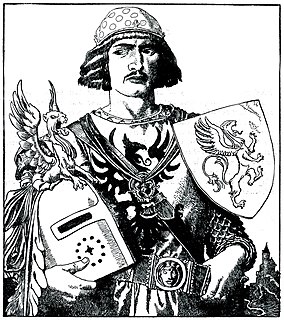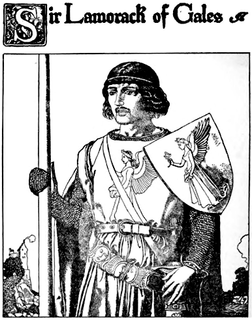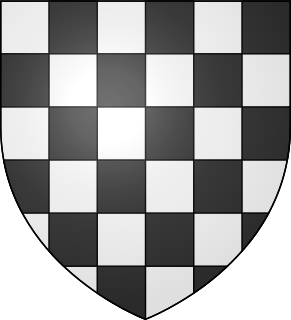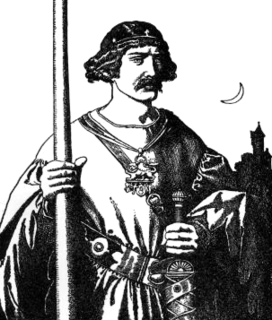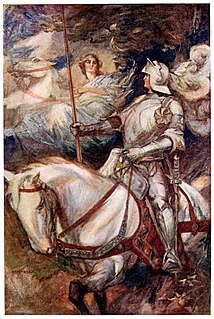This article has multiple issues. Please help improve it or discuss these issues on the talk page . (Learn how and when to remove these template messages)
|
Sir Lucan the Butler is a servant of King Arthur and one of the Knights of the Round Table in the Arthurian legend. The duties of a "butler" have changed over time; Lucan was supposed to have been in charge of the royal court, along with Bedivere the Marshal and Kay the Seneschal.

A butler is a domestic worker in a large household. In great houses, the household is sometimes divided into departments with the butler in charge of the dining room, wine cellar, and pantry. Some also have charge of the entire parlour floor, and housekeepers caring for the entire house and its appearance. A butler is usually male, and in charge of male servants, while a housekeeper is usually a woman, and in charge of female servants. Traditionally, male servants were better paid and of higher status than female servants. The butler, as the senior male servant, has the highest servant status. He can also sometimes function as a chauffeur.

King Arthur was a legendary British leader who, according to medieval histories and romances, led the defence of Britain against Saxon invaders in the late 5th and early 6th centuries. The details of Arthur's story are mainly composed of folklore and literary invention, and his historical existence is debated and disputed by modern historians. The sparse historical background of Arthur is gleaned from various sources, including the Annales Cambriae, the Historia Brittonum, and the writings of Gildas. Arthur's name also occurs in early poetic sources such as Y Gododdin.

Sir Bedivere is one of the earliest characters to be featured in the Matter of Britain, originally appearing in a number of early Welsh texts in which he is named as Bedwyr Bedrydant. In the later versions, he the Knight of the Round Table of King Arthur who serves as Arthur's marshal and eventually returns Excalibur to the Lady of the Lake. He is frequently associated with his brother Sir Lucan and his cousin Sir Griflet, as well as with Sir Kay.
Lucan is the son of Duke Corneus, brother to Sir Bedivere and cousin to Sir Griflet. He and his relatives are among Arthur's earliest allies in the fight against the rebel kings such as Lot, Urien, and Caradoc, and remained one of Arthur's loyal companions throughout his life. In most accounts of Arthur's death, from the Lancelot-Grail Cycle to Malory's Le Morte d'Arthur , Lucan is one of the last knights at the king's side at the Battle of Camlann. He is usually the last to die; he helps Arthur off the battlefield after he battles Mordred, but the stress is too much. He dies from his own wounds just before the king returns Excalibur to the Lady of the Lake and sails off for Avalon.
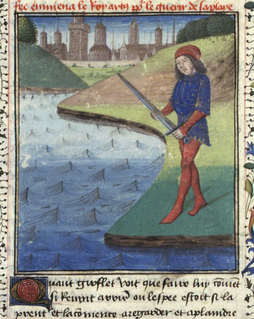
Sir Griflet, also called Giflet, Girflet or Jaufre, is a Knight of the Round Table in Arthurian legend. He is called the son of Do or Don, and he is cousin to Sir Lucan and Sir Bedivere. Like many another character in Arthurian Romance, his origins lie in Welsh mythology - in this instance in the minor deity Gilfaethwy fab Dôn, who features in Math fab Mathonwy, fourth of the Four Branches of the Mabinogi.
Lot, Loth or Lothus is the king of Lothian, the realm of the Picts in the Arthurian legend. Such a ruler first appeared late in the 1st millennium's hagiographical material concerning Saint Kentigern, which feature a Leudonus, king of Leudonia, a Latin name for Lothian. In the 12th century, Geoffrey of Monmouth adapted this to Lot, king of Lothian, in his influential chronicle Historia Regum Britanniae, portraying him as King Arthur's brother-in-law and ally. In the wake of Geoffrey's writings, Lot appeared regularly in later romance.

Urien, often referred to as Urien Rheged or Uriens, was a late 6th-century king of Rheged, an early British kingdom of the Hen Ogledd. His power and his victories, including the battles of Gwen Ystrad and Alt Clut Ford, are celebrated in the praise poems to him by Taliesin, preserved in the Book of Taliesin. He became the "King Urien of Gorre" of later Arthurian legend and his son Owain mab Urien was later known as Ywain.
Though the knight Arthur asks to cast the sword into the lake is usually Griflet (Lancelot-Grail) or Bedivere (Le Morte d'Arthur, the Alliterative Morte Arthure , the Stanzaic Morte Arthur ), the 16th century English ballad "King Arthur's Death" ascribes this duty to Lucan. [1]
The Alliterative Morte Arthure is a 4346-line Middle English alliterative poem, retelling the latter part of the legend of King Arthur. Dating from about 1400, it is preserved in a single copy, in the early 15th-century Lincoln Thornton Manuscript.
The StanzaicMorte Arthur is an anonymous 14th-century Middle English poem in 3,969 lines, about the adulterous affair between Lancelot and Guinevere, and Lancelot's tragic dissension with King Arthur. The poem is usually called the Stanzaic Morte Arthur or Stanzaic Morte to distinguish it from another Middle English poem, the Alliterative Morte Arthure. It exercised enough influence on Thomas Malory's Le Morte d'Arthur to have, in the words of one recent scholar, "played a decisive though largely unacknowledged role in the way succeeding generations have read the Arthurian legend".

English is a West Germanic language that was first spoken in early medieval England and eventually became a global lingua franca. Named after the Angles, one of the Germanic tribes that migrated to the area of Great Britain that would later take their name, England, both names ultimately deriving from the Anglia peninsula in the Baltic Sea. It is closely related to Frisian and Low Saxon, and its vocabulary has been significantly influenced by other Germanic languages, particularly Norse, and to a greater extent Latin and French.
He was a solid and reliable Knight of the Round Table and one of King Arthur's earliest companions. He took on the post of Royal butler - an important position in charge of the Royal Household rather than a serving man. He valiantly defended Arthur's right to the throne at the Battle of Bedegraine and probably against subsequent rebellions. Though he sought adventure, he never came to the fore in Arthurian tales with renowned exploits of his own. He always attended the Royal tournaments and was once hurt so badly by Sir Tristram that Sir Yvain had to escort him to Gannes Abbey for medical assistance. Sir Lucan remained loyal to King Arthur throughout the schism with Lancelot and on occasion acted as their go-between. Similarly during Mordred's rebellion he stayed by the monarch's side and though wounded, with his brother, Bedivere, he was one of the few knights left standing at the Battle of Camlann. He tried to dissuade Arthur from his final attack on his son/nephew, but was unsuccessful and the King received his mortal wound. Worried about looters on the battlefield, Lucan and Bedivere attempted to move the dying Arthur into a nearby chapel for safety; but the strain was too much for Lucan. A severe wound burst open, spilling out his bowels, and he died.
A character named Lucan appears in the 2004 film King Arthur , played by Johnny Brennan. He is a young boy found and cared for by Arthur's knight Dagonet.
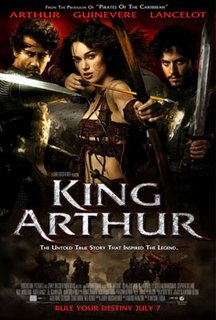
King Arthur is a 2004 Irish-British-American historical adventure film directed by Antoine Fuqua and written by David Franzoni. It stars Clive Owen as the title character, Ioan Gruffudd as Lancelot and Keira Knightley as Guinevere.
Sir Dagonet was King Arthur's well-beloved jester, and a Knight of the Round Table of Arthurian legend. He saw himself as a courageous warrior and would present himself as such. Yet, in reality, he would flee at the slightest provocation. He often battered his own shield so that it appeared that he had been in a fight – telling all that he emerged victorious of course.
Sir Lucan was a son of Duke Corneus and probably maternal half-brother of Sir Bedivere. [ citation needed ]

